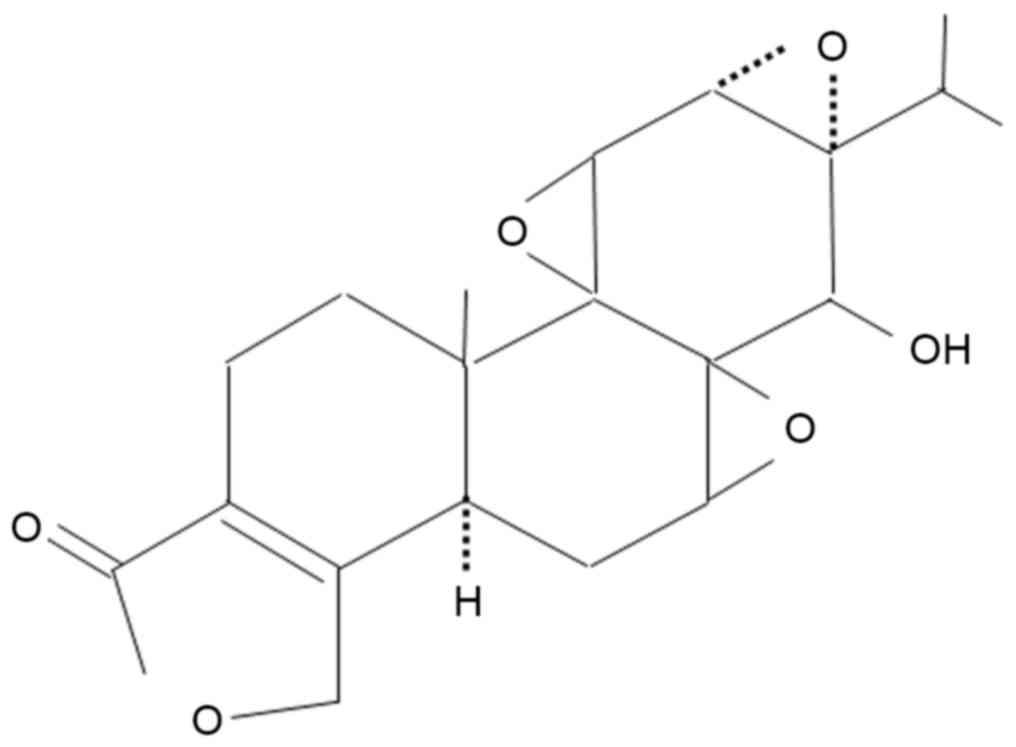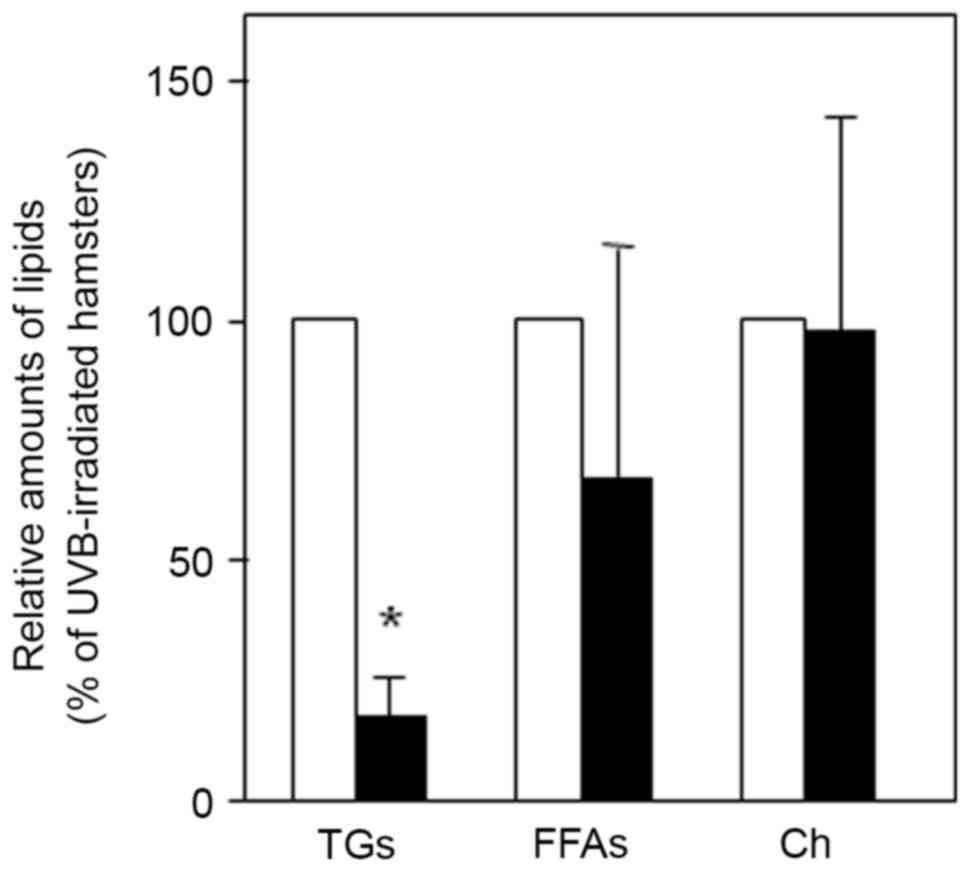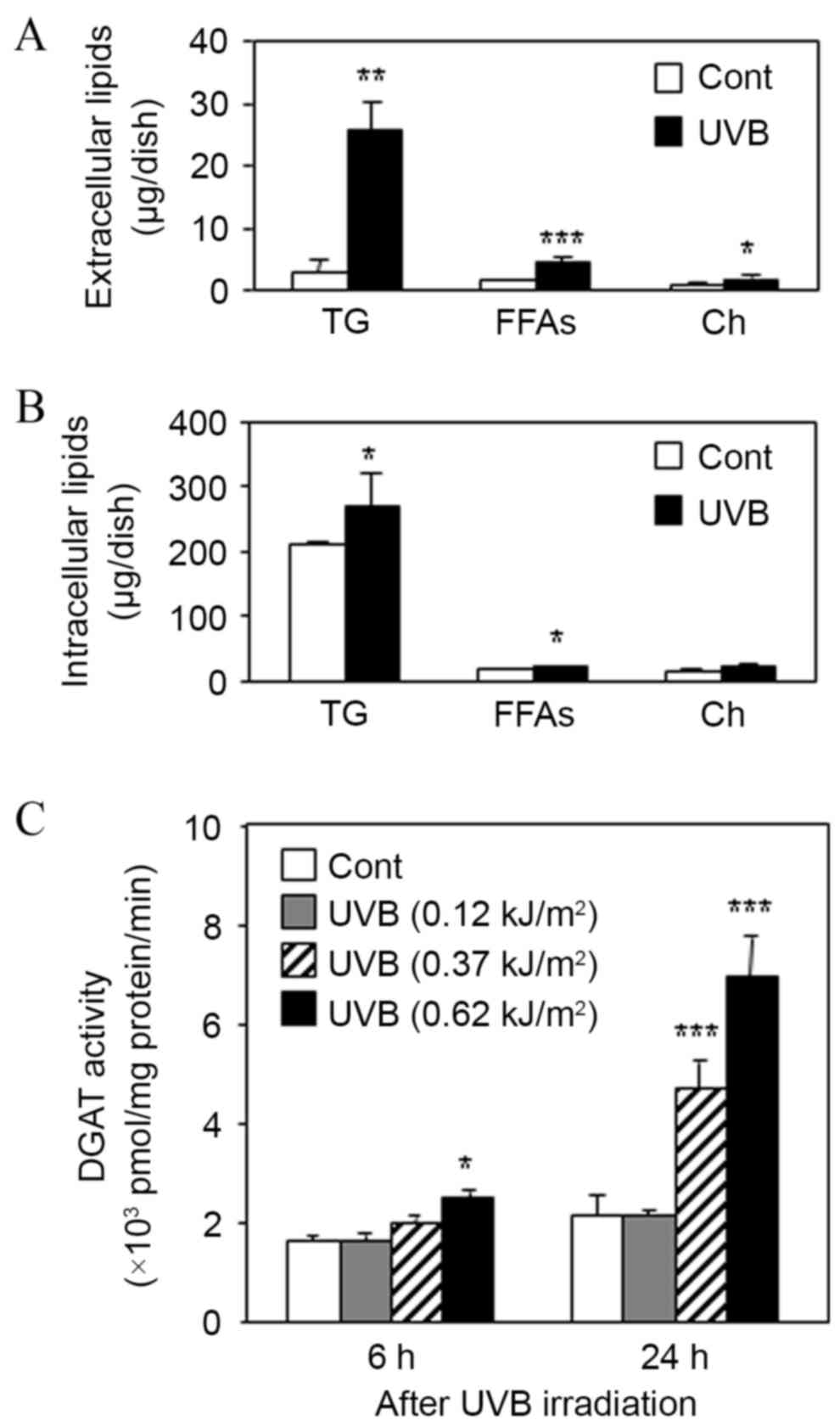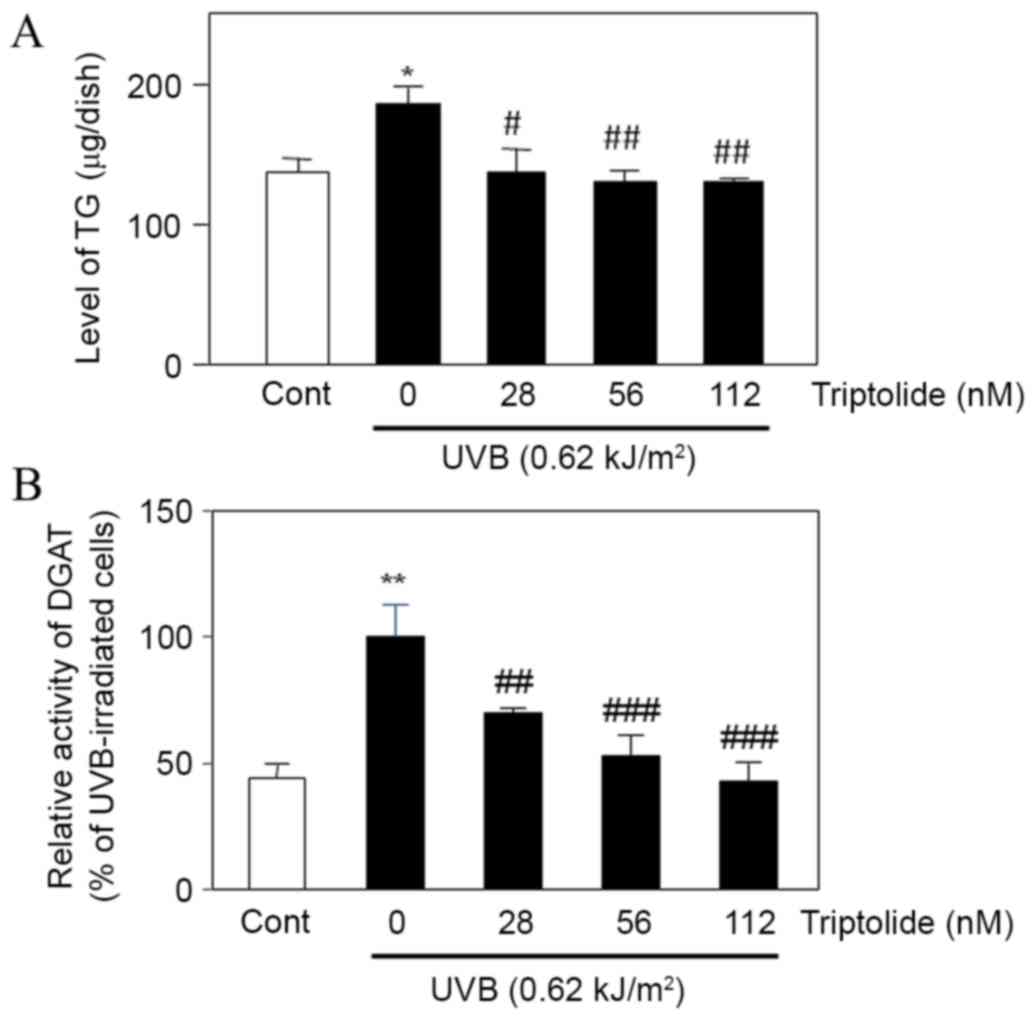|
1
|
Rabe JH, Mamelak AJ, McElgunn PJ, Morison
WL and Sauder DN: Photoaging: Mechanisms and repair. J Am Acad
Dermatol. 55:1–19. 2006. View Article : Google Scholar : PubMed/NCBI
|
|
2
|
Quan T, Qin Z, Xia W, Shao Y, Voorhees JJ
and Fisher GJ: Matrix-degrading metalloproteinases in photoaging. J
Invest Dermatol Symp Proc. 14:pp. 20–24. 2009; View Article : Google Scholar
|
|
3
|
Sambandan DR and Ratner D: Sunscreens: An
overview and update. J Am Acad Dermatol. 64:748–758. 2011.
View Article : Google Scholar : PubMed/NCBI
|
|
4
|
Jenkins G: Molecular mechanisms of skin
aging. Mech Ageing Dev. 123:801–810. 2002. View Article : Google Scholar : PubMed/NCBI
|
|
5
|
Inomata S, Matsunaga Y, Amano S, Takada K,
Kobayashi K, Tsunenaga M, Nishiyama T, Kohno Y and Fukuda M:
Possible involvement of gelatinases in basement membrane damage and
wrinkle formation in chronically ultraviolet B-exposed hairless
mouse. J Invest Dermatol. 120:128–134. 2003. View Article : Google Scholar : PubMed/NCBI
|
|
6
|
Tanaka S, Sato T, Akimoto N, Yano M and
Ito A: Prevention of UVB-induced photoinflammation and photoaging
by a polymethoxy flavonoid, nobiletin, in human keratinocytes in
vivo and in vitro. Biochem Pharmacol. 68:433–439. 2004. View Article : Google Scholar : PubMed/NCBI
|
|
7
|
Thody AJ and Shuster S: Control and
function of sebaceous glands. Physiol Rev. 69:383–416.
1989.PubMed/NCBI
|
|
8
|
Kurokawa I, Danby FW, Ju Q, Wang X, Xiang
LF, Xia L, Chen W, Nagy I, Picardo M, Suh DH, et al: New
developments in our understanding of acne pathogenesis and
treatment. Exp Dermatol. 18:821–832. 2009. View Article : Google Scholar : PubMed/NCBI
|
|
9
|
Suh DH, Kwon TE and Youn IJ: Changes of
comedonal cytokines and sebum secretion after UV irradiation in
acne patients. Eur J Dermatol. 12:139–144. 2002.PubMed/NCBI
|
|
10
|
Akitomo Y, Akamatsu H, Okano Y, Masaki H
and Horio T: Effects of UV irradiation on the sebaceous gland and
sebum secretion in hamsters. J Dermatol Sci. 31:151–159. 2003.
View Article : Google Scholar : PubMed/NCBI
|
|
11
|
Sato T, Takahashi A, Kojima M, Akimoto N,
Yano M and Ito A: A citrus polymethoxy flavonoid, nobiletin
inhibits sebum production and sebocyte proliferation, and augments
sebum excretion in hamsters. J Invest Dermatol. 127:2740–2748.
2007. View Article : Google Scholar : PubMed/NCBI
|
|
12
|
Merle C, Laugel C and Baillet-Guffroy A:
Effect of UVA or UVB irradiation on cutaneous lipids in films or in
solution. Photochem Photobiol. 86:553–562. 2010. View Article : Google Scholar : PubMed/NCBI
|
|
13
|
Kohl E, Steinbauer J, Landthaler M and
Szeimies RM: Skin ageing. J Eur Acad Dermatol Venereol. 25:873–884.
2011. View Article : Google Scholar : PubMed/NCBI
|
|
14
|
Qin WZ, Zhu GD, Yang SM, Han KY and Wang
J: Clinical observations on Tripterygium wilfordii in treatment of
26 cases of discoid lupus erythematosus. J Tradit Chin Med.
3:131–132. 1983.PubMed/NCBI
|
|
15
|
Tao XL, Sun Y, Dong Y, Xiao YL, Hu DW, Shi
YP, Zhu QL, Dai H and Zhang NZ: A prospective, controlled,
double-blind, crossover study of Tripterygium wilfordii Hook F. in
treatment of rheumatoid arthritis. Chin Med J (Engl). 102:327–332.
1989.PubMed/NCBI
|
|
16
|
Jiang X: Clinical observations on the use
of the Chinese herb Tripterygium wilfordii Hook for the treatment
of nephrotic syndrome. Pediatr Nephrol. 8:343–344. 1994. View Article : Google Scholar : PubMed/NCBI
|
|
17
|
Qiu D, Zhao G, Aoki Y, Shi L, Uyei A,
Nazarian S, Ng JC and Kao PN: Immunosuppressant PG490 (triptolide)
inhibits T-cell interleukin-2 expression at the level of
purine-box/nuclear factor of activated T-cells and NF-kappaB
transcriptional activation. J Biol Chem. 274:13443–13450. 1999.
View Article : Google Scholar : PubMed/NCBI
|
|
18
|
Lin N, Sato T and Ito A: Triptolide, a
novel diterpenoid triepoxide from Tripterygium wilfordii Hook. f.,
suppresses the production and gene expression of pro-matrix
metalloproteinases 1 and 3 and augments those of tissue inhibitors
of metalloproteinases 1 and 2 in human synovial fibroblasts.
Arthritis Rheum. 44:2193–2200. 2001. View Article : Google Scholar : PubMed/NCBI
|
|
19
|
Wu Y, Cui J, Bao X, Chan S, Young DO, Liu
D and Shen P: Triptolide attenuates oxidative stress, NF-κB
activation and multiple cytokine gene expression in murine
peritoneal macrophage. Int J Mol Med. 17:141–150. 2006.PubMed/NCBI
|
|
20
|
Lu Y, Bao X, Sun T, Xu J, Zheng W and Shen
P: Triptolide attenuates the oxidative stress induced by LPS/D-GalN
in mice. J Cell Biochem. 113:1022–1033. 2012. View Article : Google Scholar : PubMed/NCBI
|
|
21
|
Kabashima K, Nagamachi M, Honda T,
Nishigori C, Miyachi Y, Tokura Y and Narumiya S: Prostaglandin E2
is required for ultraviolet B-induced skin inflammation via EP2 and
EP4 receptors. Lab Invest. 87:49–55. 2007. View Article : Google Scholar : PubMed/NCBI
|
|
22
|
Sato T, Imai N, Akimoto N, Sakiguchi T,
Kitamura K and Ito A: Epidermal growth factor and
1alpha,25-dihydroxyvitamin D3 suppress lipogenesis in hamster
sebaceous gland cells in vitro. J Invest Dermatol. 117:965–970.
2001. View Article : Google Scholar : PubMed/NCBI
|
|
23
|
Akimoto N, Sato T, Iwata C, Koshizuka M,
Shibata F, Nagai A, Sumida M and Ito A: Expression of perilipin A
on the surface of lipid droplets increases along with the
differentiation of hamster sebocytes in vivo and in vitro. J Invest
Dermatol. 124:1127–1133. 2005. View Article : Google Scholar : PubMed/NCBI
|
|
24
|
Iwata C, Akimoto N, Sato T, Morokuma Y and
Ito A: Augmentation of lipogenesis by
15-deoxy-Delta12,14-prostaglandin J2 in hamster sebaceous glands:
Identification of cytochrome P-450-mediated
15-deoxy-Delta12,14-prostaglandin J2 production. J Invest Dermatol.
125:865–872. 2005. View Article : Google Scholar : PubMed/NCBI
|
|
25
|
Harris CA, Haas JT, Streeper RS, Stone SJ,
Kumari M, Yang K, Han X, Brownell N, Gross RW, Zechner R and Farese
RV Jr.: DGAT enzymes are required for triacylglycerol synthesis and
lipid droplets in adipocytes. J Lipid Res. 52:657–667. 2011.
View Article : Google Scholar : PubMed/NCBI
|
|
26
|
Yamamoto T, Kurasawa M, Hattori T, Maeda
T, Nakano H and Sasaki H: Relationship between expression of tight
junction-related molecules and perturbed epidermal barrier function
in UVB-irradiated hairless mice. Arch Dermatol Res. 300:61–68.
2008. View Article : Google Scholar : PubMed/NCBI
|
|
27
|
Wróbel A, Seltmann H, Fimmel S,
Müller-Decker K, Tsukada M, Bogdanoff B, Mandt N, Blume-Peytavi U,
Orfanos CE and Zouboulis CC: Differentiation and apoptosis in human
immortalized sebocytes. J Invest Dermatol. 120:175–181. 2003.
View Article : Google Scholar : PubMed/NCBI
|
|
28
|
Kurihara H, Sato T, Akimoto N, Ogura T and
Ito A: Identification and characterization of ABCB1-mediated and
non-apoptotic sebum secretion in differentiated hamster sebocytes.
Biochim Biophys Acta. 1811:1090–1096. 2011. View Article : Google Scholar : PubMed/NCBI
|
|
29
|
Trindade GS, Capella MA, Capella LS,
Affonso-Mitidieri OR and Rumjanek VM: Differences in sensitivity to
UVC UVB and UVA radiation of a multidrug-resistant cell line
overexpressing P-glycoprotein. Photochem Photobiol. 69:694–699.
1999. View Article : Google Scholar : PubMed/NCBI
|
|
30
|
Kang S, Cho S, Chung JH, Hammerberg C,
Fisher GJ and Voorhees JJ: Inflammation and extracellular matrix
degradation mediated by activated transcription factors nuclear
factor-kappaB and activator protein-1 in inflammatory acne lesions
in vivo. Am J Pathol. 166:1691–1699. 2005. View Article : Google Scholar : PubMed/NCBI
|
|
31
|
Sato T, Kurihara H, Akimoto N, Noguchi N,
Sasatsu M and Ito A: Augmentation of gene expression and production
of promatrix metalloproteinase 2 by Propionibacterium acnes-derived
factors in hamster sebocytes and dermal fibroblasts: A possible
mechanism for acne scarring. Biol Pharm Bull. 34:295–299. 2011.
View Article : Google Scholar : PubMed/NCBI
|
|
32
|
Allen HB and LoPresti PJ: Acne vulgaris
aggravated by sunlight. Cutis. 26:254–256. 1980.PubMed/NCBI
|



















